I was fascinated by this area. I have not been anywhere similar before and I really enjoyed the pioneering feeling! 10/10
Amy N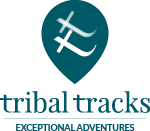
Location
Terrain
Difficulty
Accommodation and Meals
Guesthouse, Hotel, Village Homestay
Duration
10 days
Meeting Point
Colombo (or UK airport if flights included)
Annual Leave
6 days
Group Size
Up to 14
Seasons
Late June to September
Walking Distance
approx 85km over 5 days
Fully supported trek through a carefully curated trek, the terrain and landscapes are different each day - remote ridgelines, thick rainforest, stunning valleys and beautiful lakes, to name a few.
Conquer the legendary V-shaped mountain pass known locally as 'Jacob's Ladder'. Especially difficult if there has been rain as the conditions can be slippy.
Descend the 14km 'Devil's Staircase' - put your knees to work as you descend a trail of steep and sharp zig-zag twists. See the country's highest waterfall, Bambarakanda Falls.
Discover the incredible flora and fauna diversity in the UNESCO-listed Horton Plains National Park
Trek through working tea estates, colonial-era factories and villages built entirely around the tea economy
Experience the warm hospitality of the friendly Sri Lankan people
Get off the beaten track to areas that are untouched by mass tourism. Experience genuine and respectful interactions throughout
A portion of entrance fees contributes to local guide employment, trail maintenance and community infrastructure
Enjoy the sacred views of Adam's Peak (spiritually revered by Buddhists, Hindus, Christians, and Muslims)
All the info you need
Trip Details
This carefully curated trek winds its way through the central highlands of Sri Lanka, through visually dramatic landscapes, remote and nature-filled tracks and historic and culturally important points of interest. Over five days, we will trek approximately 80 kilometres, tackling over 3000m ascent and descent. The terrain is varied, from large exposed planes to thick rainforest, remote ridge lines and including both the legendary Jacob's ladder ascent and The Devil's Staircase descent.
We will trek for an average of five hours a day, and over the span of the five day trek we will ascend over 3000m, and descend over 3500m! We will relax each night in a combination of hotels, comfortable guest houses and homestays. We can expect a warm welcome everywhere we go.
**Please note we cannot provide single rooms in accommodation on the trek - rooms will be in twin and triples**
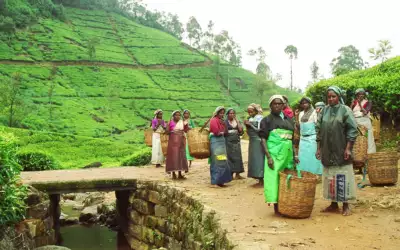
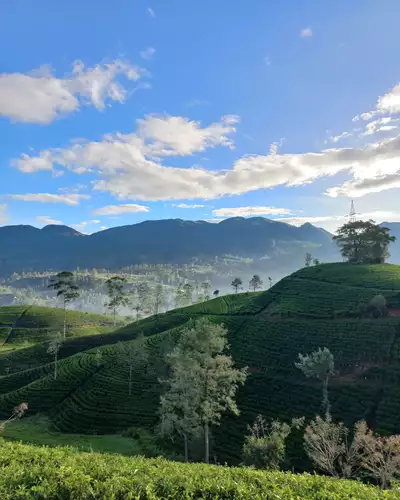
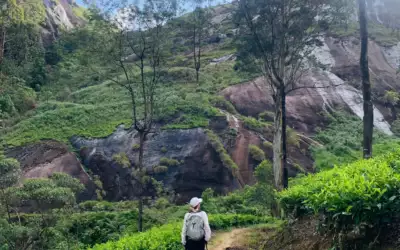
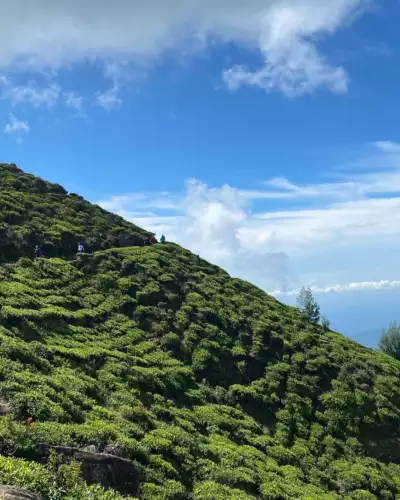
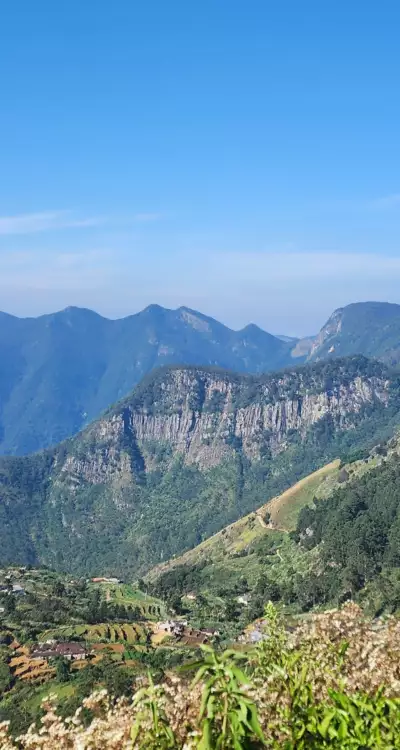
Trip Details
The first stop on our Sri Lankan Adventure
Welcome to Sri Lanka. We are met by our team and transfer to coastal town of Negombo is conveniently located around 15km from Colombo airport. We will stay in a coastal resort to relax after our long journey. If there's time, you are free to explore the area surrounding your hotel.
Accommodation and Meals
Lunch and Dinner, Hotel
Head to the Central Highlands
After a leisurely breakfast, we head for Kotagala, in the Hatton Area.
Leaving the coastal town of Negombo, the journey inland to Kotagala takes you from sea level into the heart of Sri Lanka's central highlands — a drive of around 4.5 to 5 hours that's as scenic as it is varied. You'll begin on palm-lined roads skirting paddy fields and bustling villages, before gradually climbing through cooler, greener terrain. As the altitude rises, the landscape transforms: coconut groves give way to dense forest, misty hills, and endless rows of tea bushes that roll over the hills.
The final stretch heads into the Hatton area, famous for its role in Sri Lanka's tea story. Kotagala is a small, sleepy town nestled among vast tea estates. It's best known for its historic tea plantations, the scent of fresh tea leaves is never far away — welcome to the heart of Sri Lanka's tea country, and the start point for our trek.
We arrive in time for lunch and have the afternoon at leisure, enjoying the pool and magnificent surrounding views. There will be a briefing before dinner and an early night.
Accommodation and Meals
Full board. Local guesthouse.
Trek highlights - Stunning lakes, pretty railway crossings, vast tea fields
Your journey kicks off with an early start, leaving from your charming hotel in Kotagala, nestled in the heart of Sri Lanka's lush tea country. Your luggage (except day bags) will be transferred for you.
From the first step, the trail immerses you in a landscape of rolling emerald hills and fragrant tea leaves. As you ascend gently through the plantations, around 2.5km in, you'll pass Chrysler’s Farm Tea Factory — a striking colonial-era building from 1870, its bold paintwork standing out dramatically against the sea of green. It's a landmark you simply can't miss.
Climbing higher, the views open up to reveal the charming hill town of Hatton, the 'green heart of Sri Lanka' and a main destination on Sri Lanka's tea industry map. You'll reach the tranquil Singamalai Lake — the lifeblood of the region, supplying fresh water to Hatton and its surrounding villages. It's also the perfect spot to take lunch.
After lunch, we continue our journey for around 5km, winding through rolling green tea hills until we meet the Castlereagh Reservoir, an idyllic location that looks like it is straight out of a fairytale. After taking in the views, we continue to the next landmark, a football ground, right in the middle of tea country — a testament to the sport's popularity in this area of Sri Lanka.
We pass more tea factories and sporting grounds as well as Christian churches, Hindu Kovils and brightly coloured terraced houses. At around 12km in we begin to descend into the valley, eventually reaching our accommodation - a Colonial Era Tea Planters' bungalow in the lively tea town of Norwood. We'll watch the mist roll in over the hills, with a cup of tea, of course.
Trek overview:
Length: 16km
Average Duration: 5 - 6 hours
Region: Hatton
Accommodation and Meals
Full board. Local guesthouse.
Trek highlights - Beautiful valleys and views of Adam's Peak
Norwood is the gateway to Sri Lanka's famed Bogawantalawa Valley — better known as the Golden Valley of Tea. This crossroads connects Hatton to Maskeliya, Adam's Peak, and offers a rugged route to Balangoda. Expect misty hills, mirror-still lakes, and some of the most scenic tea country in the world.
The trail starts with a steady climb, rising toward the ridge that separates the Bogawantalawa and Maskeliya valleys. While climbing away from the valley may seem odd, the payoff is huge: breathtaking views of the Maskeliya Valley and the sacred Adam's Peak, revered by Buddhists, Hindus, and Christians alike.
Continuing another 4km or so, the low-trodden trail dips into Kew Estate, passing a small Hindu shrine and becoming narrower and more secluded as we go.
We wind through exposed tea fields (remember your hat!) before joining the main road near a charming colonial church where the pioneering 19th-century photographer, Julia Margaret Cameron, is buried.
Passing the historic Planters' Club, the route gently descends into Bogawantalawa town (home to some of Sri Lanka's most legendary tea estates), where we'll arrive in time for lunch. We will stay in one of the comfortable homestays in the town.
Trek overview:
Length: 16km
Average Duration: 4.5/5 hours
Region: Hatton
Accommodation and Meals
Full board. Homestay (group may split into 2/3 homestays but eat centrally).
Trek highlights - The legendary Jacob's Ladder ascent, rural farmland, rolling hills
Today we have an early start. After a filling breakfast, we hit the trail once again. We trek towards the imposing Bogawana Tea Factory, then beyond it to the iconic mountain pass known locally as 'Jacobs Ladder', which we will ascend via its narrow zig-zag path. The trail takes us aay from the bustling tea plantations, making way for serene grasslands and rolling hills, where it's unlikely you'll see many other people at all.
We head into the forest and continue for a couple of kilometers along this trail, where eucalyptus trees will shade you. Stay quiet to avoid startling the local wildlife. When the forest opens up, you enter the remote Agarapatna Valley. Once we reach the road head at Dayagama, we'll transfer in our fleet of tuk-tuks for a 20-minute ride to our cosy accommodation.
Trek overview:
Length: 17km
Average Duration: 5-6 hours
Region: Ohiya
Accommodation and Meals
Full board. Local guesthouse.
Trek highlights - Rainforest climb into Horton Plains
After breakfast, we have a short transfer to the start of today's trek, the village of Dayagama, one of the most remote villages in the tea country.
Today's trek is tough, physically and mentally. It is a steady uphill climb of almost 1000m. The first 9.5km of the trek follows obvious trails, walking towards the dense forest and entering Horton Plains National Park. We'll stop here for lunch. Once inside the park, we ascend through dense rainforest, which is alive with the sounds of a whole plethora of wildlife. Think birds, monkeys, deer and leopards. You are truly at one with nature here.
Once we reach the road, we will be picked up in our small coach and transferred to our accommodation in the village of Ohiya.
Trek overview:
Length: 16km
Average Duration: 6 hours
Region: Haputale
Accommodation and Meals
Full board. Local hotel or guesthouse
Trek highlights - Dramatic descent via Devil's Staircase, abandoned factories, remote ridgelines
This morning, we have a short transfer from our accommodation to the top of the Devil's Staircase, dubbed as one of the most scenic treks in Sri Lanka. The descent takes us down a steep, rocky, and uneven trail to Idalgashina, where we continue to Haldumula town for lunch. Along the way, you will be treated to far-reaching views, including some of the country's most stunning waterfalls. This section of the route is around 14km long.
After lunch, we continue our descent to meet our vehicle at the road head. The last kilometre of our trek (174km into the 300km Pekoe trail) is officially named in memory of Scottish rugby union legend, Tom Smith.
Trek overview:
Length: 20km
Average Duration: 6-7 hours
Region: Haputale
Accommodation and Meals
Full board. Resort in Haputale/Beragalla
Galle, a UNESCO World Heritage Site
We have an early departure and travel to Galle on the southwest coast. This should take around four hours.
Galle is best known for the Galle Fort, a UNESCO World Heritage Site originally built by the Portuguese in the 16th century and later fortified by the Dutch. Once we arrive at our hotel, we have the afternoon at leisure.
Walking through its cobbled streets feels like stepping into a time capsule — you'll find grand colonial buildings, quirky boutiques, art galleries, and chic cafés tucked inside centuries-old walls, all with the scent of sea breeze in the air.
If you would prefer to relax, you can do so at our charming hotel, enjoying the laid-back vibe.
Accommodation and Meals
Full board. Hotel in Galle.
Trip Details
Trip Details
In a nutshell, almost everything!
This is what you will need to buy/source yourself.
It is important that you read the itinerary carefully, and take account of the rating we have given it.
Although our challenges are not technical, they do require a good degree of physical fitness. The conditions will require stamina and strength, which you should recognise and train for. This will be a much better experience if you are fit and prepared. You should feel comfortable walking 6-8 hours per day.
In setting the maximum size of our groups, we take a number of factors into account.
Altitude, degree of difficulty, the terrain, the climate and time of year, all determine the maximum group size. Sometimes it will be 20, sometimes it will be 8-14, but safety is always our priority.
You will be accompanied by a Tribal Tracks UK Leader, Mountain Leader qualified, as well as supported by our local, in-country guides.
It is a requirement of Tribal Tracks booking terms and conditions that each supporter must hold their own travel insurance, which covers the trip and the activities they are doing. Read more here.
We advise you to put insurance in place as soon as possible, ideally on booking so you are covered immediately. Your insurance must be valid and in date, covering the entire period that you are travelling for, including the return journey home. It should cover medical and personal accident risks, and should include repatriation costs and air ambulance or helicopter rescue services, where appropriate.
Tribal Tracks has 100% Financial Protection and has a trust account with the Protected Trust Service, member number 5566.
This means that all client monies paid to Tribal Tracks are held in our dedicated trust account, which is supervised by an independent trustee. This means that in the very unlikely event that Tribal Tracks ceases to trade, your money is safe. For more information, please visit this link. Any flights booked for you by Tribal Tracks will be ATOL-protected under our own ATOL certificate.
Tribal Tracks considers the safety of all of its participants and staff to be a top priority, and as such we have thorough safety systems in place.
In the event of an injury, we have an evacuation plan in place for all elements of the trek route. We do ask that you look after yourself during the trek in the following way, as this will help avoid unnecessary problems:
We know that the unexpected can happen.
While you are away, things can happen at home and people may need to get in contact with you. This can be tricky when you are in remote areas. So, shortly before departure, we provide you with an Emergency Procedure document to distribute to your nearest and dearest. This sets out how to contact Tribal Tracks and the steps Tribal Tracks will then take to get in contact with you.
It is really important that you are well prepared for your physical challenge and that you are confident that you will be able to fully participate.
Although our leaders are well trained to deal with different capabilities, if they have any concerns about someone’s ability to safely partake in the trek, or their impact on other people’s enjoyment, we authorise them to take necessary action which, in some circumstances, may involve asking someone to step out of the trek. Although this is a very rare occurrence, by booking this trip you agree to section 11 of our Booking Conditions which clearly states that our leaders have the authority to do this. In these circumstances, we will ensure anyone sitting out is safely provided for and offered alternative options where possible. Refunds will not be provided for activities missed and customers may be liable for additional costs incurred.
At Tribal Tracks, Responsible Travel is enormously important to us, and our commitment to responsible travel is evidenced in every itinerary that we prepare.
Core to our business is the belief that holidays can and should be enjoyable to the traveller but should be conducted in a socially, environmentally and economically responsible manner which brings benefit to local communities. This is implemented through a variety of measures which can be found in our Responsible Travel policy. We encourage you to read this and to play your own part in travelling responsibly.
Trip Details
Trip Details
The trek is a challenge. We will be walking for a long time over sometimes challenging terrain with steep ascents and descents.
The best way to build endurance fitness is to start with some gentle walks and gradually build up both the distance and duration over the next few months. In the last 2 months, we would recommend to go out and do long days, ideally in the hills, to build up the strength in your legs. About a week before the trek, limit any training to short walks – you want to have fresh legs at the start!
For the trek you should be comfortable trekking between 6 - 8 hours per day, but remember we have all day to achieve the distances and will not be going at racing snake pace. It may sound obvious, but make sure that you are walking properly, hitting the ground with your heel first, then rolling onto your toe, which pushes you onto the next step (this will help reduce the risk of shin splints and tendon pulls). Walk with your head up, eyes forward and shoulders level.
It is a good idea to develop a level of cardiovascular fitness (exercising and strengthening your heart and lungs). This comes from running, cycling or swimming for between 20 minutes and an hour, and will really help develop your endurance fitness. Three sessions a week is normally advised, increasing time and distance over time.
Replicate conditions in training i.e., use all the kit you will be using and try your walking poles if you want to use them.
It is important to pack so that you know where everything is. Separating kit into different packing cubes, or even plastic bags can really help with this. You can pack by item (eg socks and pants in one cube, tops in another etc) or by day, putting your entire outfit for that day together in one place. Taking an extra bag or cube to separate dirty kit is a great idea.
You will have two bags on the trip - your main bag and your back pack.
You should operate on the basis that you will not have access to your main bag during the day and while you are trekking. This means that it is important to have everything you need in your back pack. Waterproofs should go in the bottom, together with an extra layer, sunscreen and sunglasses, plus hat and gloves (if you are in a colder climate). You should also have your water bottles, and any specific snacks, medicines or first aid items you want to take, such as zinc tape and blister plasters. Baby wipes/toilet roll and nappy sacks are also essential for going to the toilet while you are trekking - we will explain more in the pre-departure briefing!
In the event of an injury, we have an evacuation plan in place for all elements of the trek route. We do ask that you look after yourself during the trek in the following way, as this will help avoid unnecessary problems:
We will brief you in the pre-departure briefing as to the catering specifically for your trip. However, as a guide, each morning you will be provided with a very filling local breakfast, usually accompanied by tea or coffee. Lunch will be during your trek and will be prepared by the team of cooks or we will utilise local restaurants or teahouses. Food will always be ample and tasty. If wild camping, dinner will be in the dining tent and will be traditional, freshly prepared food. If you are staying in a hotel or teahouse, dinner will be served there. Water, tea and coffee will be served and alcohol will usually not be available, although there will be some exceptions. We will provide 4 litres of drinking water per person per day. You will need to fill up 2 litres at breakfast and another 2 litres at lunchtime.
Please ensure that you have notified us before departure if you have any specific dietary requirements or allergies as we can cater for most.
Please inform us of any dietary requirements or allergies before you travel, and preferably at the time of booking. We can cater for almost all diets, but only if we know about them beforehand.
You will sleep in shared tents (unless a single supplement has been requested). Mattresses are provided, which makes it much more comfortable! There will be a central dining tent available with rugs and lights where the group can get together in the evening, share stories and enjoy meals. There will also be an open fire wherever it is possible.
Sleeping bags are designed to work by trapping your body heat in the down surrounding you. If you wear lots of layers, your body heat will not be able to escape as effectively, and you will be cold. Wearing a thin thermal layer is ideal. It does sound counter intuitive, but we promise that it works!
Putting your clothes for the next day in the bottom of your sleeping bag will also help with warmth, as it will fill up any spare space around your feet, and it will mean your clothes are nicely warmed up in the morning.
If you find it difficult to sleep without a pillow, we recommend that you take a travel pillow and a regular pillowcase with you. Put your pillow in the pillow case, and use your down jacket/layers to fill out the pillowcase, you will end up with a pretty decent pillow!
And as for stuff or roll when it comes to packing your bag away? We are very much in the stuff camp! Read more here.
There will be early morning starts, typically around 0600 - 0700hrs, so that the team can set off on the trek in good time. It is important that you pack up your kit before breakfast and leave your bag outside your tent or accommodation so that the crew can load them onto the jeeps and/or mules. There will be a freshly cooked lunch provided on your trek route. The aim is to get into camp before sunset if possible, when you can enjoy a hot drink and snacks. It is important that you change into your thermals and put layers on when you get into camp as the temperatures can drop sharply and you need to keep warm.
In the morning, the Tribal Tracks leader will wake up the group. When you hear the call, please begin to get ready, and pack all your kit away in your 'main bag' before breakfast. Put this bag outside your tent or accommodation as the crew can then begin to break down the tents/load the luggage. Ensure that you have all that you need in your backpack for the day, as you will not have access to your main bag until the next camp (see 'What do I put in my backpack?).
When you arrive into camp, it is important to get changed into different clothes, usually the ones that you will be wearing the next day. Even if you have had dry weather, you will have been sweating, and your clothes will be damp. As the sun sets and the air cools, you will quickly feel cold. Before this, you will want to freshen up and we recommend the 'baby wipe bath'. As there are no showers while on the trek, having a freshen up with a baby wipe will help keep you clean and will make you feel much better, before you put your clean clothes on. Unpack your sleeping bag and get everything out that you need for nighttime, such as your warm hat, jacket, head torch and book. Sort out your back pack for the next day by removing rubbish and replenishing snacks etc.
Doing this before dinner will mean you can get into your sleeping bag quickly, when it is likely to feel cold.
There will be a toilet tent and water supplied for washing in the morning where we can. There are no shower facilities provided during the trek and there will be no toilets either, but there will be a toilet tent in camp in the evenings and mornings. In the pre-departure briefing, we will tell you all that you need to know about how to deal with this.
For up-to-date vaccinations information please visit the NHS website ‘Fit for Travel’ at: http://www.fitfortravel.nhs.uk. The Tribal Tracks team are travel professionals, but we are not medical experts, and we would encourage you to visit your GP or travel nurse to discuss vaccination requirements. Please remember to take your itinerary with you so that they can see where you will be travelling. You should make an appointment at least 3-4 months before you travel.
In addition, please note that information on vaccinations can change at short notice; we recommend that you contact your Medical Professional or a Travel Health Clinic at least 8 weeks prior to departure for the most up to date information.
We recommend that you bring a multi-region adapter plug with you. There will be no facility to recharge electrical items on the trek, so we recommend you bring a power bank to top up the charge. We also recommend putting your phone on Airplane mode during the day to save on power.
Using your mobile overseas can sometimes attract unwelcome, very high tariffs. We recommend that you check with your network provider before you travel, but if in doubt, keep your phone switched to Airplane mode and use it only when there is WiFi. Reception can also be patchy, and unreliable, particularly in remote areas, which is why we carry a satellite phone with us. Please let your nearest and dearest know about this, and warn them that you may not be able to be in regular contact.
We ask that your luggage is kept to the absolute minimum. We will tell you the weights that you should not exceed, but usually, your main bag should not exceed 23kgs in weight.
It is important that you wear, or take your trekking boots with you in your hand luggage on the flight, as they are vital for the trek and cannot be replaced in the event of lost luggage.
We recommend leaving behind items such as high value jewellery, watches etc. Your passport and money should be always kept on you.
Trekking at high altitude (generally above 2500 metres) involves additional risk not normally associated with lower level treks. This is not something that should prevent you from undertaking a trek to our higher destinations, but it makes sense to learn about the dangers inherent in trekking at high altitude and also the ‘golden rules' to prevent Acute Mountain Sickness (AMS).
For each of our trips, you can find the maximum altitudes listed on the web site and in the itineraries. You should read the itinerary carefully and use your own judgement to gauge whether your chosen trip is suitable for your level of experience. If you have any doubts at all you should contact us and we are happy to discuss the trip with you.
You can acclimatise to altitude by the process known as acclimatisation. The most important rule is to gain height slowly and it is generally accepted that the maximum safe altitude gain in any one day is 500 metres once above 2500 metres. Where this is not possible, then it is important to have a rest or acclimatisation day at the new altitude before gaining further height. All our itineraries follow this rule. In general the maxim ‘climb high and sleep low' applies. It is perfectly acceptable (and even beneficial to your acclimatisation) to climb higher than 500 metres above your last camp (for example when crossing a high pass) as long as the increase in sleeping altitude remains within the above rule. All of our itineraries are carefully designed to build in optimum acclimatisation.
There is a link between daily fluid intake and successful acclimatisation and you must pay particular attention to hydration during trekking at high altitudes. On treks to 3000 metres and above most people will need to drink between 5 and 6 litres each day to achieve suitable hydration levels and you must adopt a responsible approach to achieving this target. It goes without saying that as alcohol is a diuretic, it is not recommended that you drink alcohol while at altitude.
Before embarking on a trek to high altitude it is important that you familiarise yourself with the signs and symptoms of Acute Mountain Sickness (AMS) and that you report any illness to your tip leader straight away. See the links at the bottom of this page for further reading on AMS.
There are a number of untested herbal remedies which claim to prevent mountain sickness. However, only one drug is currently known to have a useful role in preventing AMS and to be safe for this purpose: acetazolamide (Diamox). We recommend that you carry Diamox in your first aid kit for treks where you spend an extended period above 4000m. Diamox can only be obtained from a medical professional on prescription and it is important that you first consult your own doctor so that you know there are no contra indications with other medicines you may be taking and that you do not have an allergy to acetazolamide. Diamox commonly causes some minor side effects, such as tingling fingers and toes, or a metallic taste in the mouth, but more severe reactions are rare. On trek, the decision whether or not and when, you should take Diamox as with any drug, will rest solely with you. If you intend to take Diamox, you must familiarise yourself with the appropriate dosage and regime prior to coming on the trip. The links at the bottom of this page will provide further information on the use of Diamox as an aid to acclimatisation.
Travelling to high altitudes is not something you need to be scared of. Every year thousands of people enjoy the most amazing experiences in the world's greatest mountain ranges. Altitude sickness is entirely preventable if you follow the very simple rules and procedures detailed above. Please make sure you are aware of these before you travel. However, please be assured that we have emergency procedures in place in the event that someone does experience AMS.
For further reading on the above issues we recommend the following websites:
http://www.altitude.org/altitude_sickness.php
Trip Details
Have a question about Tribal Tracks? Get in touch, our small team will be delighted to help.